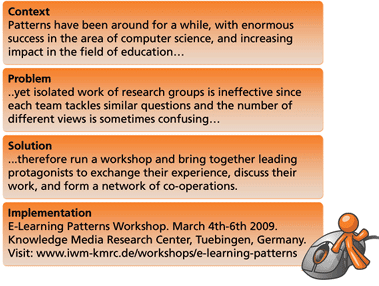 Home | Call for Abstracts | Registration | Program The Essential Structure of Teaching Method DescriptionsSusanne
Neumann, Michael Derntl, Petra Oberhuemer Instructors’ practice of planning teaching has been in the focus of research with the goal to extract teaching methods that represent best teaching practice. This investigation is coupled with the hope that the documentation of best practice teaching methods enables other instructors to adopt these teaching methods. The research question discussed in this article regards the description structure in which teaching methods are captured so that other instructors can easily understand and apply the methods in their own contexts. Fourteen description schemas for teaching methods were reviewed including pattern catalogues, learning design repositories, and didactic scenario collections. The description schemas were mainly collected from higher education institutions and research groups across the globe. After accumulating the elements used in the schemas to see which elements are most often used in description schemas, a method for excluding elements was established. The foundation for this elimination process built a project carried out within the Joint Information Systems Committee (JISC), namely Mod4L, where information needs of instructors were investigated while they browsed, chose, developed, and implemented teaching methods. The elements needed during each of these phases were then matched with the previously accumulated elements from the fourteen description formats. The result is a new description structure for teaching methods, which is presented in this article. The new structure captures the essence of the teaching method and enables the instructor to apply the method to their context. This is also achieved by coupling each generic description of a teaching method with an actual implementation of that method. Currently, about twenty teaching methods have been transferred into the new description structure. Instructors across Europe have evaluated the structure in two ways: for the purpose of describing their own teaching methods using the structure, and for the purpose of understanding and applying teaching methods described by others. |
|

